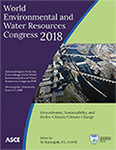World Environmental and Water Resources Congress 2018
Water Treatment Using Renewable Energy Technologies—A Pilot Plant Study
Publication: World Environmental and Water Resources Congress 2018: Groundwater, Sustainability, and Hydro-Climate/Climate Change
ABSTRACT
Disinfection of water by exposure to sunlight is an age-old concept. Historically, as a religious practice, copper containers filled with water were left in sunlight for hours to make it potable. In the last century, a renewed interest to develop sustainable water disinfection concepts for under developed communities has been revived. Many research studies incorporate water treatment systems involving both thermal and optical inactivation of bacteria. Progress focuses on increasing the effectiveness of systems by adopting improved reflector surface materials and shapes. Water depth and suspended solids are primary factors which impact the penetration of sunlight. Reduction of suspended solids can be achieved either by sedimentation or filtration. Filters comprised of natural material can make the system sustainable and reduce costs. To investigate the performance of such a water treatment system, a pilot water treatment plant using no fossil fuels was designed and tested. The plant consists of filters using natural materials, solar panels to operate a pump for moving water from the source, a natural stream in a highly urbanized area to the plant, and reflector basins to gather and focus natural sunlight for disinfection (SODIS). A reflective circular-section open channel was adopted for optical disinfection by sunlight. The study indicates an inverse relation between flow rate and disinfection rates. The pre-disinfection filters contributed to a reduction in bacterial concentration of the resulting water, and this form of SODIS was successful in achieving the minimum 30-day average E. coli concentrations necessary for recreational water access.
Get full access to this chapter
View all available purchase options and get full access to this chapter.
ACKNOWLEDGMENT
We thank the EWRI for giving us the opportunity to present this work.
References
Amaro-Ortiz, A., Yan, B., and D’Orazio, J. A., 2014, “Ultraviolet Radiation, Aging and the Skin: Prevention of Damage by Topical cAMP Manipulation” Journal on Molecules; 19(5):6202–19.
Baker, K. H., Hegarty, J. P., Redmond, B., Reed, N. A., Herson, D. S., 2002, “Effect of Oxidizing Disinfectants (Chlorine, Monochloramine, and Ozone) on Helicobacter pylori”, Applied and Environmental Microbiology, 68(2):981–4.
Blough, N. V., Zepp, R. G., 1995, “Reactive oxygen species in natural waters”, Active Oxygen in Chemistry, Chapman and Hill, New York, pages 280–333.
Collins, M. R. 1998. “Assessing Slow Sand Filtration and Proven Modifications.’’ In Small Systems Water Treatment Technologies: State of the Art Workshop. NEWWA Joint Regional Operations Conference and Exhibition. Marlborough, Massachusetts.
Cutchis, P. 1991 “A formula for comparing annual damaging ultraviolet (DUV) radiation doses at tropical and midlatitude” US Department of Transportation, pages 213–228.
Downes, A., Blunt, T. P., 1877 “Researches on the effect of light upon bacteria and other organisms” Proceedings of the Royal Society of London, Pages 488–500.
Eisenstark, A., 1987 “Mutagenic and lethal effects of near ultraviolet radiation (290–400 nm) on bacteria and phage” Environmental Molecular Mutagen, 10(3):317–37.
Goodsell, D. S., 2001 “The Molecular Perspective: Ultraviolet Light and Pyrimidine Dimers” Journal of Stem Cells, vol. 6 no. 3, 298–299.
Hendricks, D., 1991, “Manual of Design for Slow Sand Filtration”, AWWA Research Foundation and American Water Works Association, Denver, Colorado.
Huisman, L., Wood, W. E., 1974, “Slow Sand Filtration”, World Health Organization.
Yao-Xing, Liu, Tong Ou, Yang, Dong-Xing, Yuan, Xiao-Yun, Wu, 2010 “Study of municipal wastewater treatment with oyster shell as biological aerated filter medium”, Desalination, Volume 254, Issues 1–3.
Jagger, J., 1981, “Near-UV radiation effects on microorganisms”, Photochemical Photobiology, Volume 34, Issue 6, pages 761–768.
Katsumi, N, Shinobu, W, Tana, Kaoru I, Yoshikatsu, K, Keiji, O, Tatsuji, Y, Hiroshi, K, 2001 “Adsorption Effect of Activated Charcoal on Enterohemorrhagic Escherichia coli”, Journal of Veterinary Medical Science, Vol. 63, P 281–285
Lee, Z., C. Hu, S. Shang, K. Du, M. Lewis, R. A., and R. B., 2013, “Penetration of UV-visible solar radiation in the global oceans: Insights from ocean color remote sensing”, Journal of Geophysics Research, Volume 118, Issue 9, pages 4241–4255.
Liu, Yao-Xing & Ou Yang, Tong & Yuan, Dong-Xing & Wu, Xiao-Yun, 2010., “Study of municipal wastewater treatment with oyster shell as biological aerated filter medium”, Desalination. 254. 149–153.
Lloyd, R. E., Rinkenberger, J. L., Hug, B. A., Tuveson, R. W., 1990, “Growing Escherichia coli mutants deficient in riboflavin biosynthesis with non-limiting riboflavin results in sensitization to inactivation by broad-spectrum near-ultraviolet light (320–400 nm)”, Photochemical Photobiology, 52(4):897–901.
Mbonimpa, E. G., Vadheim, B., Blatchley, E. R. III 2012, “Continuous-flow solar UVB disinfection reactor for drinking water”, Water Research, Volume 46, Issue 7, Pages 2344–2354.
Naylor, M. F., Boyd, A, Smith, DW, Cameron, GS, Hubbard, D, Neldner, KH, 1995, “High sun protection factor sunscreens in the suppression of actinic neoplasia”, Arch Dermatology, 131(2):170–5.
Rosa, G., Miller, L., and Clasen, T., 2010, “Microbiological effectiveness of disinfecting water by boiling in Guatemala”, The American Journal of Tropical Medicine and Hygiene, 82(3):473–7.
Sammartano, L. J., Tuveson, R. W., 1987, “Escherichia coli strains carrying the cloned cytochrome d terminal oxidase complex are sensitive to near-UV inactivation”, Journal of Bacteriology, 169(11):5304–7.
Schwartzenbach, R. P., Gschwend, P. M., Imboden, D. M., 2003, “Environmental Organic Chemistry” 2nd edition John Wiley and Sons.
Information & Authors
Information
Published In
World Environmental and Water Resources Congress 2018: Groundwater, Sustainability, and Hydro-Climate/Climate Change
Pages: 287 - 293
Editor: Sri Kamojjala, Las Vegas Valley Water District
ISBN (Online): 978-0-7844-8141-7
Copyright
© 2018 American Society of Civil Engineers.
History
Published online: May 31, 2018
Authors
Metrics & Citations
Metrics
Citations
Download citation
If you have the appropriate software installed, you can download article citation data to the citation manager of your choice. Simply select your manager software from the list below and click Download.
